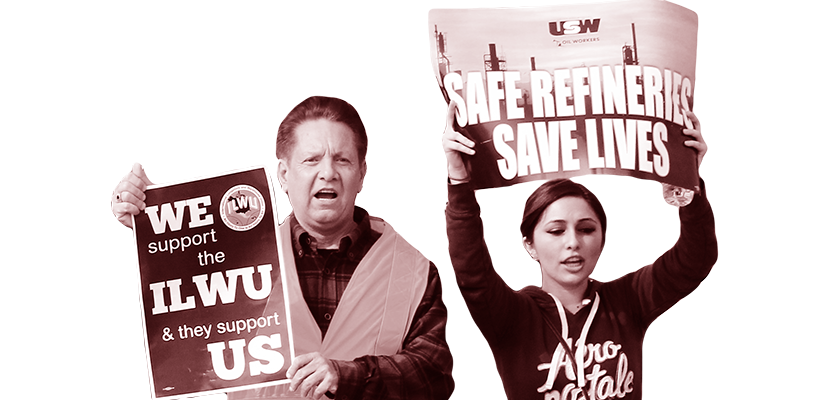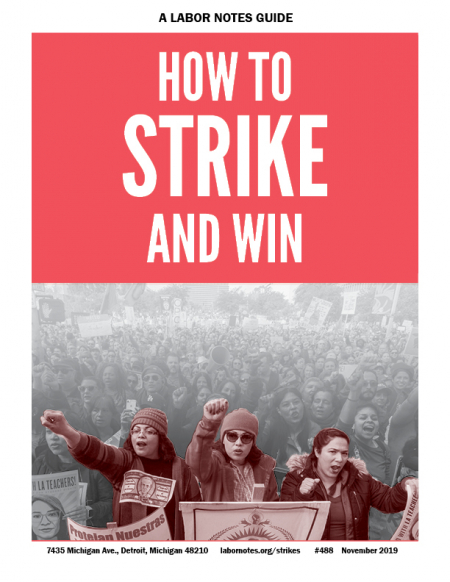Ways to Strike

There are numerous types of strikes that it is possible to deploy. Photo: Slobodon Dmitrov.
Workers have invented a wealth of variations on the strike. Some are riskier than others. Some pack more punch.
How to Strike and Win
A Labor Notes Guide
labornotes.org/strikes
The Big Picture
Know Your ABC's
Building Blocks
- Turn Up the Heat
- Organize the Organized
- Democracy: Who Owns the Strike?
- Community: Who Else Owns It?
- How to End a Strike
At a Glance
Open-ended strikes are the classic type, the kind most often mentioned in this booklet. The strike goes on until the two sides reach a tentative agreement. Think Verizon workers in 2016, Marriott hotel workers in 2018, or Los Angeles teachers in 2019.
In one-day or short strikes, the union often announces in advance how long the strike will last. A short strike is less punishing for workers—but also for the boss. It’s sometimes called a “demonstration strike,” since it can be a warning shot before escalation.
Short strikes are common in health care, where it’s rare to fully shut down services. Health care workers are required to give 10 days’ notice before a strike, and a hospital will usually hire scabs—professionals it will have to house in hotels and pay big bucks. This means that workers’ leverage is front-loaded in the early days, when the employer incurs the biggest costs and the greatest disruption in the workplace occurs, so staying out longer won’t necessarily produce an advantage for the union.
An economic strike is about wages, benefits, or working conditions, while an unfair labor practice strike is about the employer’s violations of labor law. This distinction is important because ULP strikers have protections against permanent replacement that economic strikers do not. See here.
In symbolic strikes, stopping work is used as a form of public protest rather than to exercise direct power against the boss. Typically these strikes don’t involve many workers and don’t shut down operations. The point may be to generate attention and public pressure, like the Fight for $15 actions in fast food that started in 2012.
Lockouts are the inverse of strikes: the employer refuses to allow workers back on the job until the union signs a contract on the employer's terms. Lockouts can feel scary and discouraging, as the employer seems to have the upper hand. But they actually have some significant practical advantages over strikes.
Employers are barred from permanently replacing locked-out workers. In most states, locked-out workers can get unemployment benefits. If the lockout is found to be unlawful—an unfair labor practice—the employer is on the hook for back pay. You don’t have to worry about members crossing the picket line. And there’s a public sympathy factor— it’s obviously the employer’s fault!
In rolling strikes, the action moves from workplace to workplace or department to department. Workers thin their pain by sharing it, while the employer continually takes the brunt.
Teachers in Washington state have used rolling strikes repeatedly to press the legislature to improve pay. They held one-day walkouts in 30 school districts in 1999 and 65 school districts in 2015.
“The beauty of the rolling strikes was that we could keep them up for a long time, because each strike had just one day’s impact on the members,” said President Kevin Teeley of the Lake Washington local. “But the legislature was subjected to the impact for many days. They saw hundreds and thousands of us daily.”
Intermittent strikes are a series of short strikes for a common goal—and they fall outside the protections of the National Labor Relations Act (NLRA), on the grounds that they are too disruptive to the employer. But there are some work-arounds; see here.
The Association of Flight Attendants’ strategy of “Creating Havoc Around Our System” (CHAOS) is explicitly a strategy of intermittent, rolling strikes. The first use was in 1993, when flight attendants at Alaska Airlines announced they would be striking random flights. The unpredictability drew enormous media attention and drove management up the wall.

SUPPORT LABOR NOTES
BECOME A MONTHLY DONOR
Give $10 a month or more and get our "Fight the Boss, Build the Union" T-shirt.
Although the union struck only seven flights in a two-month period, Alaska had to send scabs on every plane, just in case. Flight attendants come under the Railway Labor Act, not the NLRA, and a court found these strikes legal.
Recognition strikes try to force a nonunion employer to accept the union and bargain. Common in the 1930s and again among public employees in the 1960s and 1970s, they have become rare—but they’re still possible, as workers at the Piston Automotive factory in Toledo, Ohio, proved in 2014. Such strikes can be combined with first-contract demands.
A solidarity or sympathy strike honors someone else’s picket line. For instance, when service and hospital workers at the University of California (AFSCME Local 3299) struck twice in 2018, professional and technical workers in the same facilities (UPTE-CWA) joined them in solidarity strikes. In 2019, both unions struck again, but this time it was UPTE who initiated and AFSCME who struck in solidarity.
It helped that both unions had expired contracts. Most contracts ban strikes while the contract is in effect; depending on the language, this may include sympathy strikes. Labor law recognizes two exceptions—if the original strike is over a serious ULP, or if you have to stop work to avoid an “abnormally dangerous” working condition, such as a physically dangerous picket line. Nonunion workers have the right to honor picket lines—but they have no legal protection against being permanently replaced, unless they are honoring a ULP strike.
Every union should add language to its contract explicitly granting the right to honor picket lines. Teamsters are known for insisting on this contractual right, which means they can helpfully tangle up freight and UPS deliveries to a struck employer. If you’re planning a strike and want Teamsters to honor it, notify their local unions and Joint Council in advance and ask for support. But if you want other unions to support your strike, you should be doing strike support work consistently for others, and long before making the ask.
Political strikes aim at influencing government policy, like West Coast dockworkers’ short strikes against apartheid and the Iraq War. In 1969 West Virginia miners won a state law offering compensation for black lung disease. Mass strikes by immigrants in 2006 and 2017 drew attention to detentions, deportations, and immigrant rights. From 1995 to 1998, Ontario unions held rolling strikes from city to city against the conservative government’s anti-worker policies.
Wildcat strikes are those not officially called by the union but rather arising from rank-and-file action—usually during the term of the contract, making them illegal. In some cases union officials may deliberately turn a blind eye.
A wave of wildcat strikes by teachers, postal workers, and other public workers in the 1960s and 1970s led to the massive growth of unions in those sectors.
Wildcats are rare in the U.S. today, but internationally they’re more common. In China all strikes are wildcats, since the only permitted union never calls one. Nonetheless strikers have won wage increases at the factory level and labor law improvements nationally.
A sickout is a variation on the wildcat with a little more cover—technically, the strikers call in sick. Detroit teachers in 2016 used rolling sickouts to draw attention to crumbling school facilities. During the 2018-2019 federal shutdown, TSA officers called in sick at three times the usual rate, forcing some airports to shut down whole terminals and building pressure to end the shutdown.
Sickouts can also be used in place of a one-day strike after the contract expires. But if questioned, workers should admit they are trying to pressure the employer. Sick pay should not be requested or accepted.
In a sit-down strike or occupation, workers take over the workplace rather than picketing outside. It’s a powerful move, since the employer can’t even try to resume operations. The sit-down was big in the organizing drives of the 1930s but has become very rare.
The most famous recent example was by the Electrical Workers (UE) at the Republic Windows and Doors plant in Chicago, slated to shut down in 2008. Management began selling off the machinery but resisted paying workers the severance they were owed. Workers brought in locks and chains, prepared to lock their bodies to the machines if necessary.
After six days of occupying the plant, with hundreds of supporters rallying outside, the workers won all their demands. They went on to buy the machinery and reopen their factory as a worker-run co-op.
The general strike is the mother of all strikes, when workers in an entire city, state, or country shut down at once. Seattle’s 1919 general strike terrified the powerful because workers not only brought business to a halt but also reopened various services under workers’ control—setting up public dining halls, profitless grocery stores, and a barber shop co-op.
Real general strikes are illegal since 1947 and rare today, though the term gets thrown around whenever a group feels moved to call for a protest. In Puerto Rico in 2019, though, a general strike combined with massive demonstrations forced two successive governors to resign—it was a political strike as well.





